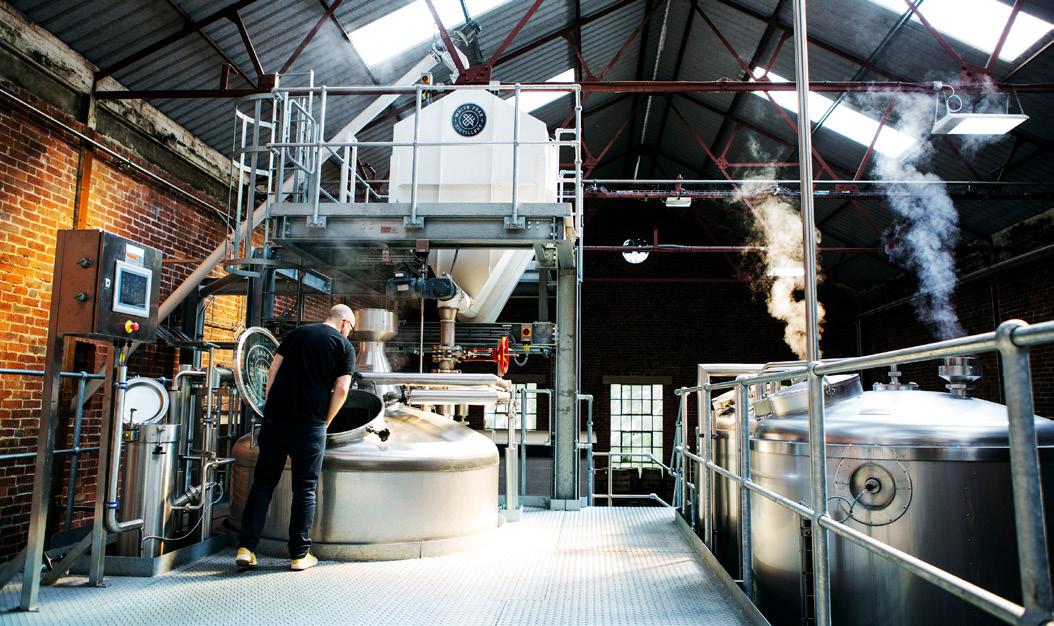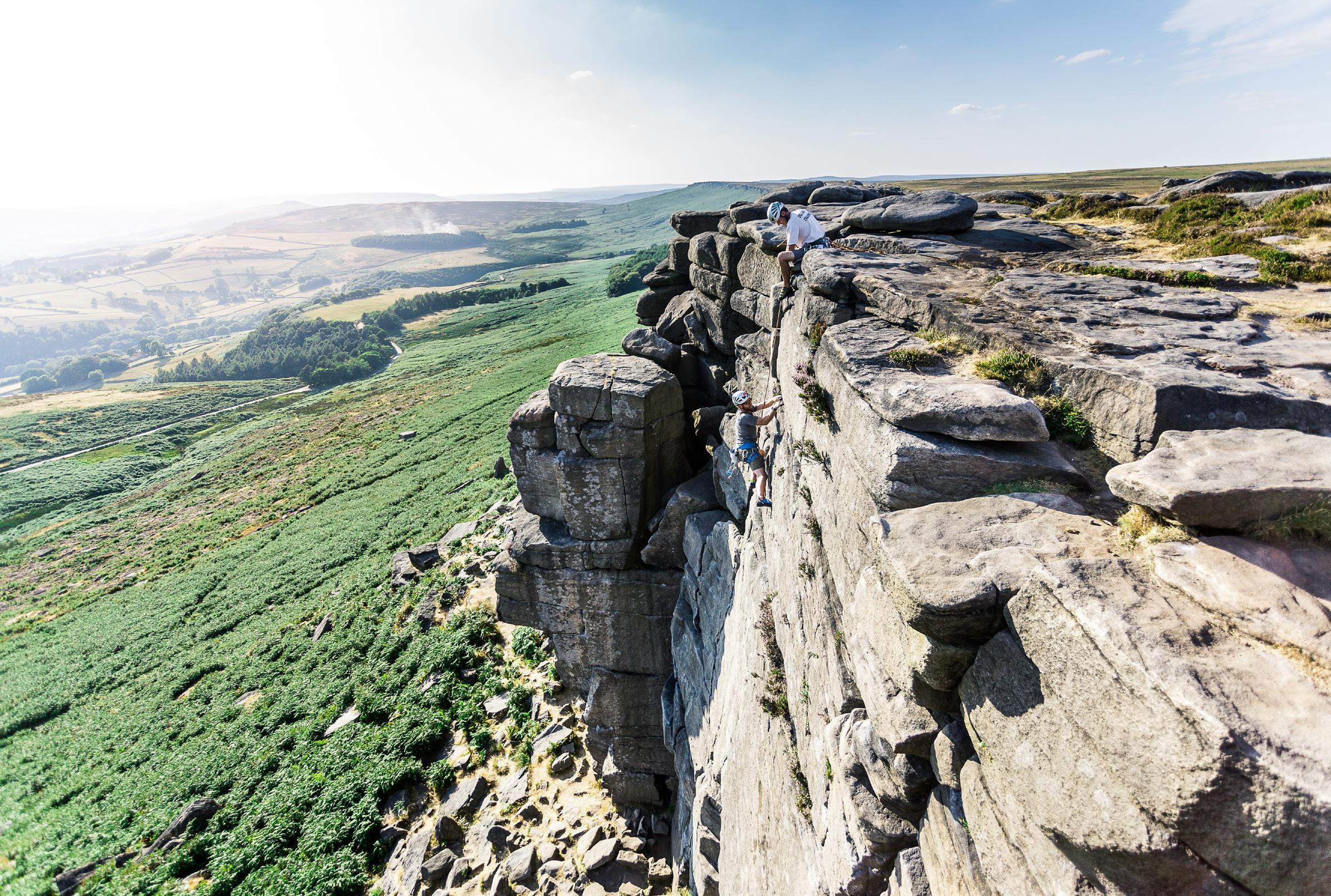
9 minute read
The Peak District and Derbyshire's Foodie Trail
Earn your calories by hiking and biking your way around the Peak District and stop along the way to indulge in the area’s Bakewell pudding, gingerbread, artisan cheese, and gourmet meals.
As cycle routes go, they don’t come much more scenic than this. My son and I are peddling along the impressive limestone gorge formed by the River Wye, which circumnavigates 300ft Chee Tor. Our track is the old Midland Railway, which stopped functioning in 1968, leaving a flat route with views of the surrounding countryside as well as from the magnificent Monsal Viaduct.

Along the Monsal Trail’s eight and a half miles are a series of well-lit tunnels, some about a quarter of a mile long, where temperatures seemingly dip to within a degree of a dementor’s breath.
The end of the line is Bakewell, and where better to stop for a little sustenance than The Old Original Bakewell Pudding Shop. Yes, Bakewell Pudding, not tart, which, as our waitress tells us with a smile, is “something invented by Mr Kipling” .
The pastry, jam and almond pudding was created by accident in 1860 at a local inn, when the cook neglected to stir the egg mixture into the pastry so spread it atop the jam instead. His lack of stirring caused quite a stir; the candlemaker’s wife, Mrs Wilson, heard how well the botched pudding had gone down, obtained its recipe, and made the sweet treats from her 17th-century cottage, now the Pudding Shop.
They still make them here by hand, according to the original secret recipe, though they’ll share it with you if you sign up for a pudding-making session. Or, like us, you can just tuck into one in the tearoom. With a bit of custard or cream it slips down a treat after all that cycling (you can even accompany it with Bakewell Pudding gin or cider).

That’s the beauty of the Peak District: you can earn your calories by hiking and biking, then cash them in on all the amazing food and drink in the vicinity. And you’ll be surprised by how much there is.
Just a four-minute cycle from Bakewell is Thornbridge Brewery, where the delicious tasting of six craft beers might put a wobble in your wheels. Their first bitter, Lord Marples, was produced using a secondhand 10-barrel kit in the grounds of co-owner Jim Harrison’s Thornbridge Hall in 2005.
Now made in a new brewery, the beer is exported to 35 countries around the world. The convivial taproom sells pizzas with beer in their dough as well as a multitude of different brews. They include the flagship Jaipur IPA (yeast used in its Chatsworth Farm Estate Shop production is used by another drinks producer in Derbyshire, White Peak Distillery; its Wire Works single malt and Shining Cliff gin can be sipped after a tour of their Belper factory).

If your eyelids are starting to feel heavy after all the eating, drinking and exercise, take heart – there are two excellent foodie hotels within a 10-minute drive of Thornbridge: The Peacock at Rowsley and The Cavendish at Baslow.
As we find, there is more feasting to be had at both, starting in the Peacock’s beamed bar with its settles, open fire and small alcove where a sparkling peacock image is emblazoned on the wall tiles. Here, we tuck into delicious hot sourdough and treacle bread as we enjoy a pre-dinner drink (try the Swift Nick or Bakewell Best, which are brewed locally).


Better still, you can hike between the two hotels on a 90-minute scenic route that leads along the River Derwent right in front of the stately pile itself. That means that if you want to base yourself in one hotel rather than both, you can easily head out on foot and have lunch in the other
The main event is served on original Mouseman tables in the dark-green dining room, and it’s superb. My starter of scallop with seaweed and tempura cauliflower is perfectly cooked, followed by the tastiest of vegetarian wellingtons with mushrooms on the side. My son, meanwhile, rhapsodises over his beautifully cooked and seasoned estate venison.
It’s equally as good at The Cavendish at Baslow, the Duke and Duchess of Devonshire’s hotel, where we devour delicious starters of tuna with seaweed and glazed pork cheek before moving onto roast celeriac cannelloni (me) and a exquisite taste of Chatsworth beef (him). Better still, in the airy, thoughtfully designed bedrooms with views over rolling fields, there’s a generous supply of luxury Chatsworth biscuits should you get the midnight munchies.
Breakfast at both hotels runs the gamut from toasted bacon sandwich or baked avocado to kippers and a full English, ideal to fuel a yomp on the 1,000-acre Chatsworth Estate parkland created by Capability Brown. There’s plenty to see as well as the magnificent house itself, including the One Arch Bridge close to a ruined mill, and Queen Mary’s Bower, a stone platform built when Mary Queen of Scots was held at Chatsworth.
Better still, you can hike between the two hotels on a 90-minute scenic route that leads along the River Derwent right in front of the stately pile itself. That means that if you want to base yourself in one hotel rather than both, you can easily head out on foot and have lunch in the other. Be sure, too, to visit the Chatsworth farm shop with its estate beef and venison among its offerings, as well as rose-pink gin.

Another day, another cycle route. This one, the Tissington Trail, starts in Ashbourne, where the timberframed Ashbourne Gingerbread Shop is a superb place to stock up with treats for the trail. Made by hand on a daily basis from a recipe that was allegedly supplied by French prisoners of war billeted in the town during the Napoleonic Wars, the gingerbread people are deliciously buttery with just a hint of spice. They’re a bargain at a pound a pop and perfect for a scooby snack on the hoof.

While the Tissington Trail may not be as scenic as the Monsal trail, and it has a distinct uphill incline as you head north towards Parsley Hay on the 13-mile route, its advantage is that you can leave it at Thorpe, cycle through the village to Dovedale car park, then enjoy a stroll through the vale, with its famous stepping stones.
Or keep going north and veer off the trail at the end to Hartington, a pretty village in the Dales that feels like a prosperous market town, complete with a duck pond. There are proper meals on offer at the Devonshire Arms, but I recommend stocking up for an impromptu picnic at the quaint Old Cheese Shop, which sells a tasty range from the nearby Hartington Creamery. The Dovedale Blue is good, as is the Peakland White with chilli, but my vote goes to the Hartington Stilton, creamier and less crumbly than other Stiltons.

“We cut into a new 8kg Stilton every day,” says owner Chris Roberts, relating that Derbyshire’s Stilton was originally produced in the Duke of Devonshire’s creamery in 1900 and later held a warrant to King George V in the 1930s. “That really put Hartington on the map although the stilton production has now gone from industrial to artisan.”
Although we’ve had the cheese course, our foodie journey isn’t over, for the complete experience, we decide to add cutlery and crockery to the mix. First up, we visit The David Mellor Country Shop at Hathersage for a fascinating tour around the cutting-edge round factory, designed by Sir Michael Hopkins. Perusing the range of cutlery in the Design Museum, from the cutlery used by Sir Ranulph Fiennes on his Transglobe Expedition to that used as ceremonial tableware in Downing Street, we can see why the late David Mellor was nicknamed the ‘cutlery king’.


He didn’t confine himself to cutlery, though – many items synonymous with the typical British street scene were designed by him, including bus shelters, traffic lights, litter bins and postboxes, which are all on show here. There’s superb food too in the Riverside Kitchen, a cafe where everything was designed by David’s son Corin, with a menu of superb soups, salads and sourdough sandwiches.
Work it all off with a walk at nearby Stanage Edge, channelling your inner Keira Knightley from the Pride & Prejudice film as you gaze over the stunning views of the Dark Peak moorlands.

To add crockery to our cutlery, our final stop is Denby Pottery Village, about an hour south. Unlike many potteries, they source clay locally here and produce their own glazes. On a tour, we see just how many stages there are in the production process – the decorated mugs, for instance, take three weeks to make and pass through 25 different pairs of hands.

We gaze into the flames in the 164ft kiln, one of nine on site, and watch a specialist potter make it all look easy before we try to make our own creations on the potter’s wheel.
All I’ll say is that it’s nowhere near as easy as it looks. In future, I’m definitely sticking to eating from dishes rather than making them.
Jane Knight and her son were guests of Visit Peak District & Derbyshire on a foodie trail. Rooms at The Peacock at Rowsley cost from £175, B&B; thepeacockatrowsley.com . Rooms at The Cavendish at Baslow cost from £216, B&B; devonshirehotels.co.uk
For more information go to visitpeakdistrict.com










